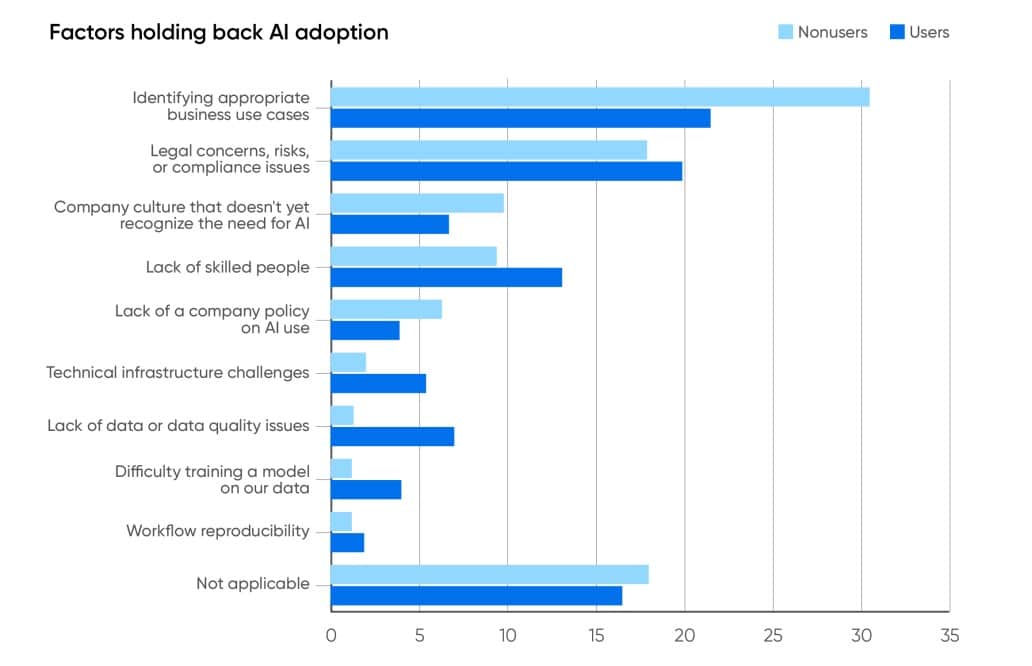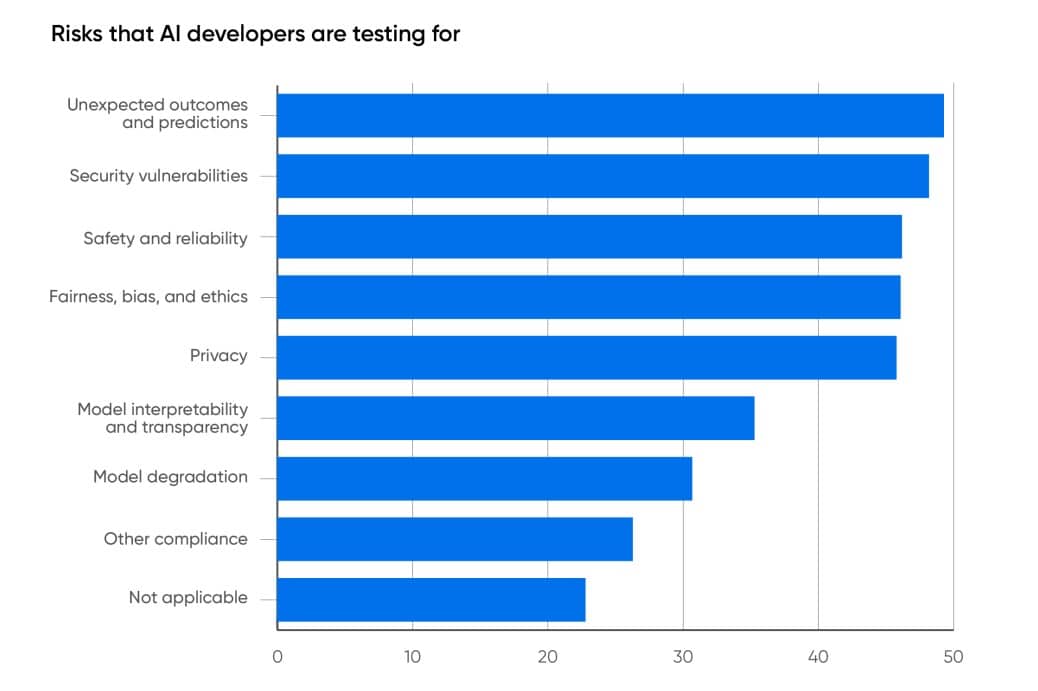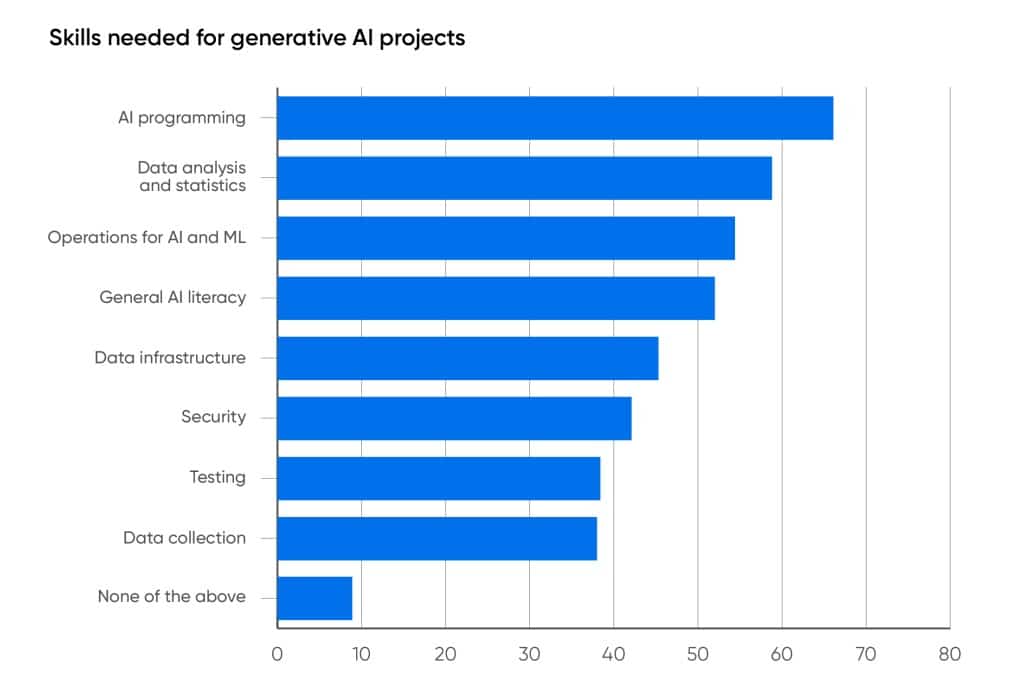2024 will be a landmark year in business tech. We’ll obviously continue to see AI saturate business operations, with advances we may not be able to envision just now pushing the tech further into customer relations, productivity, automation and more, getting more lifelike at every turn. But the implications of a rush to deployment may also catch up to us, with an unimaginable fallout. Buckle up, it’s going to be a wild ride.
The new Generative AI in the Enterprise report from biztech training and insights firm O’Reilly, based on a global survey of more than 2,800 technology professionals, explores the realities of generative AI in the enterprise in 2023, exploring how companies use it, the bottlenecks holding back adoption, and the skills gaps that should be addressed to move these technologies forward.

“Generative AI is a gateway to a new era of opportunity for businesses, with the potential to drive growth, optimize operations, and deliver exceptional customer experiences that set them apart from the competition,” said Mary Treseler, chief content officer at O’Reilly, in a news release. “But without the proper talent in place to manage it, this rapidly evolving technology can quickly outpace enterprise resources. As this groundbreaking report unveils, we are far from reaching the peak of what generative AI can achieve, and organizations still have time to invest in the critical skills development required to be at the forefront of the AI revolution.”
Fastest technology adoption on record—and it’s just getting started
Generative AI has seen a more rapid adoption than any other technology in recent history. Two-thirds (67 percent) of those surveyed report that their companies are currently using generative AI, and over a third of this group (38 percent) report that their companies have been working with AI for less than a year. While some firms like Gartner have proposed that AI might be at the top of its hype cycle, the results of the survey suggest there’s a lot more headroom.
As generative AI technology evolves, training models and developing complex applications on top of these models is becoming easier, and many open-source models—leveraged by 16 percent of those surveyed—require fewer resources to run. Also fueling the rush to adoption are the generations of tooling released within just a single year.
Tools that automate complex prompts, tools that allow for archiving and indexing prompts for reuse, and vector databases for document retrieval are more common, helping put generative AI within reach for more organizations.

Barriers and risks
Despite widespread adoption of generative AI, many companies are still in the early stages. While 18 percent of respondents report having applications in production, there remain multiple bottlenecks for enterprises looking to implement these technologies. The top constraint respondents cited is identifying appropriate use cases (53 percent), and the second is a combination of legal issues, risk, and compliance (38 percent).
Accelerated integration of generative AI has also created a demand for technology workers with the expertise to move efforts along, with AI programming (66 percent), data analysis (59 percent), and operations for AI/ML (54 percent) the most-needed skills. General AI literacy (52 percent) is also critical, as users have learned when encountering the hallucinations generative AI tools sometimes exhibit.
In terms of risk, O’Reilly asked those whose companies are working with AI what they’re testing for. The top five responses were unexpected outcomes (49 percent), security vulnerabilities (48 percent), safety and reliability (46 percent), fairness, bias, and ethics (46 percent), and privacy (46 percent).
Generative AI in action
The report found that 54 percent of AI users believe generative AI tools will lead to greater overall productivity, with only 4 percent pointing to lower head counts. Where generative AI is currently being used, the survey found that the most common application is programming (77 percent), using tools like GitHub Copilot or ChatGPT. Data analysis (70 percent) and customer-facing applications (65 percent) round out the top three use cases for generative AI in the enterprise right now, with additional nods to the technology’s help in generating marketing (47 percent) and other forms of copy (56 percent).

Other key findings include:
- Reflecting the early stages of adoption across organizations, 34 percent are at the proof-of-concept stage with generative AI. Another 14 percent are in product development, while 10 percent are building models. And a remarkable 18 percent report already having AI applications in production.
- Among respondents, 64 percent have shifted from using prepackaged generative AI to developing custom applications—representing a significant leap forward that requires investment in people, infrastructure, and skills.
- While it’s not surprising that 23 percent of respondents are using one of the GPT models, 16 percent report that their companies are building on top of open source models—demonstrating a vital and active world beyond GPT. LLaMA and Llama 2 (2.4 percent) and Google Bard (1 percent) were the least used models.
“The adoption of generative AI is certainly explosive, but if we ignore the risks and hazards of hasty adoption, it is certainly possible we can slide into another AI winter,” said Mike Loukides, vice president of content strategy at O’Reilly and author of the report, in the release. “By taking a pragmatic approach versus rushing into production, investing in training and resources, and thinking creatively about how to put AI to work, enterprises have an enormous opportunity in front of them. As the report concludes, ‘AI won’t replace humans, but companies that take advantage of AI will replace companies that don’t.’”








